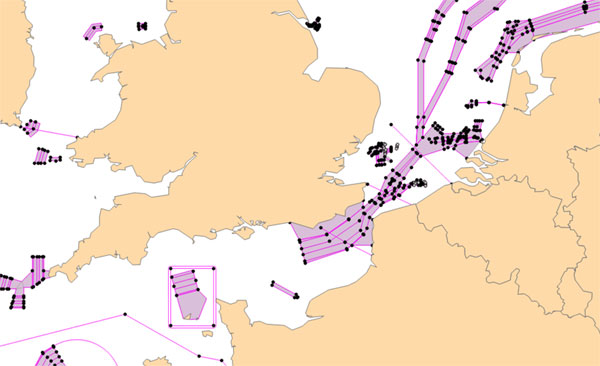Once every few months we'll email you about site additions and cruising news - unless you unsubscribe, of course!
Crossing TSS
There are many Traffic Separation Schemes (TSS) in operation around the British Isles (see diagram below) and in other areas where commercial traffic is dense. Rule 10 of "Collregs" (International Regulations for Preventing Collisions at Sea) require small leisure craft to cross lanes heading at right angles to the traffic, or alternatively report entry to the scheme. Fines can be applied if you don't obey the rules. Further hints follow.
Vessels Coming from Port. The first lane of traffic you meet will be coming from port, and will expect you to maintain course and speed. Choose an approach to the TSS which clearly passes astern of a vessel in the TSS. This will not be easy if a cluster of ships are approaching, so consider delaying your crossing. In visibilities below 5nm, and without radar, it will not be possible to choose a gap, so you must cross the first lane and expect traffic to alter course to pass astern of you. If a collision risk does subsequently arise, most ships will turn starboard to go behind you. However, some may stand on. At a late stage, be prepared to turn starboard 180° in good time to reverse your course.
In the TSS. Once in the TSS, head at right angles to the traffic lanes (it doesn't matter how the boat tracks across the ground).
Vessels Coming from Starboard. Ships which cannot identify a boat as being under sail (low visibility) may (correctly) behave as if you are under power. Those from starboard will therefore expect to be stand-on vessels, and will expect you to alter course to pass astern of them. However, if they note you're under sail, they may change course themselves. This uncertainty about their behaviour can be removed if sail boats cross under engine, showing a cone (day) or motoring light (night) and removing the jib.
Most ships like to travel on the outer edge of the lane unless overtaking, so the outside part of each lane is most dense with traffic.
It's better to avoid crossing where many commercial ferries also cross, since these may restrict your room to manouevre.
new See this 30 second time lapse video of Dover straits traffic.
Detecting Collision Course. A converging ship which remains on a constant bearing from you is on a collision course. Practice using your compass to detect this. If you have radar, learn how to use it for the same purpose.. AIS helps communications where there are doubts about a boat's intentions. However, it's not universal.

Last reviewed Oct 2018
To save yourself money (and help pay site costs) buy discounted charts and pilot books through our Book Store
Alternatively, send me the price of a beer or two through PayPal

